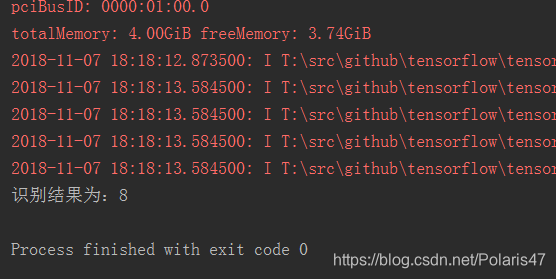載入卷積神經網路實現手寫體數字識別
阿新 • • 發佈:2018-12-20
上一篇部落格中,我們已經訓練好了模型
接下來我們要載入模型並識別真實場景下的一個手寫體數字
在此之前,我們先要準備好一張28*28畫素的影象(可用ps製作),然後通過處理將畫素的強度值變為0-1之間,之後即可輸入模型進行識別。
儲存已訓練的模型檔案如下:

程式碼如下:
import tensorflow as tf import matplotlib.pyplot as plt from PIL import Image def imageprepare(imagepath): im = Image.open(imagepath) #讀取的圖片所在路徑,注意是28*28畫素 plt.imshow(im) #顯示需要識別的圖片 plt.show() im = im.convert('L') tv = list(im.getdata()) tva = [(255-x)*1.0/255.0 for x in tv] return tva def weight_variable(shape, name): initial = tf.truncated_normal(shape, stddev=0.1) # 生成一個截斷的正態分佈 return tf.Variable(initial, name=name) # 初始化偏置 def bias_variable(shape, name): initial = tf.constant(0.1, shape=shape) return tf.Variable(initial, name=name) # 卷積層 def conv2d(x, W): # x input tensor of shape `[batch, in_height, in_width, in_channels]` # W filter / kernel tensor of shape [filter_height, filter_width, in_channels, out_channels] # `strides[0] = strides[3] = 1`. strides[1]代表x方向的步長,strides[2]代表y方向的步長 # padding: A `string` from: `"SAME", "VALID"` return tf.nn.conv2d(x, W, strides=[1, 1, 1, 1], padding='SAME') # 池化層 def max_pool_2x2(x): # ksize [1,x,y,1] return tf.nn.max_pool(x, ksize=[1, 2, 2, 1], strides=[1, 2, 2, 1], padding='SAME') # 名稱空間 with tf.name_scope('input'): # 定義兩個placeholder x = tf.placeholder(tf.float32, [None, 784], name='x-input') y = tf.placeholder(tf.float32, [None, 10], name='y-input') with tf.name_scope('x_image'): # 改變x的格式轉為4D的向量[batch, in_height, in_width, in_channels]` x_image = tf.reshape(x, [-1, 28, 28, 1], name='x_image') with tf.name_scope('Conv1'): # 初始化第一個卷積層的權值和偏置 with tf.name_scope('W_conv1'): W_conv1 = weight_variable([5, 5, 1, 32], name='W_conv1') # 5*5的取樣視窗,32個卷積核從1個平面抽取特徵 with tf.name_scope('b_conv1'): b_conv1 = bias_variable([32], name='b_conv1') # 每一個卷積核一個偏置值 # 把x_image和權值向量進行卷積,再加上偏置值,然後應用於relu啟用函式 with tf.name_scope('conv2d_1'): conv2d_1 = conv2d(x_image, W_conv1) + b_conv1 with tf.name_scope('relu'): h_conv1 = tf.nn.relu(conv2d_1) with tf.name_scope('h_pool1'): h_pool1 = max_pool_2x2(h_conv1) # 進行max-pooling with tf.name_scope('Conv2'): # 初始化第二個卷積層的權值和偏置 with tf.name_scope('W_conv2'): W_conv2 = weight_variable([5, 5, 32, 64], name='W_conv2') # 5*5的取樣視窗,64個卷積核從32個平面抽取特徵 with tf.name_scope('b_conv2'): b_conv2 = bias_variable([64], name='b_conv2') # 每一個卷積核一個偏置值 # 把h_pool1和權值向量進行卷積,再加上偏置值,然後應用於relu啟用函式 with tf.name_scope('conv2d_2'): conv2d_2 = conv2d(h_pool1, W_conv2) + b_conv2 with tf.name_scope('relu'): h_conv2 = tf.nn.relu(conv2d_2) with tf.name_scope('h_pool2'): h_pool2 = max_pool_2x2(h_conv2) # 進行max-pooling # 28*28的圖片第一次卷積後還是28*28,第一次池化後變為14*14 # 第二次卷積後為14*14,第二次池化後變為了7*7 # 進過上面操作後得到64張7*7的平面 with tf.name_scope('fc1'): # 初始化第一個全連線層的權值 with tf.name_scope('W_fc1'): W_fc1 = weight_variable([7 * 7 * 64, 1024], name='W_fc1') # 上一場有7*7*64個神經元,全連線層有1024個神經元 with tf.name_scope('b_fc1'): b_fc1 = bias_variable([1024], name='b_fc1') # 1024個節點 # 把池化層2的輸出扁平化為1維 with tf.name_scope('h_pool2_flat'): h_pool2_flat = tf.reshape(h_pool2, [-1, 7 * 7 * 64], name='h_pool2_flat') # 求第一個全連線層的輸出 with tf.name_scope('wx_plus_b1'): wx_plus_b1 = tf.matmul(h_pool2_flat, W_fc1) + b_fc1 with tf.name_scope('relu'): h_fc1 = tf.nn.relu(wx_plus_b1) # keep_prob用來表示神經元的輸出概率 with tf.name_scope('keep_prob'): keep_prob = tf.placeholder(tf.float32, name='keep_prob') with tf.name_scope('h_fc1_drop'): h_fc1_drop = tf.nn.dropout(h_fc1, keep_prob, name='h_fc1_drop') with tf.name_scope('fc2'): # 初始化第二個全連線層 with tf.name_scope('W_fc2'): W_fc2 = weight_variable([1024, 10], name='W_fc2') with tf.name_scope('b_fc2'): b_fc2 = bias_variable([10], name='b_fc2') with tf.name_scope('wx_plus_b2'): wx_plus_b2 = tf.matmul(h_fc1_drop, W_fc2) + b_fc2 with tf.name_scope('softmax'): # 計算輸出 prediction = tf.nn.softmax(wx_plus_b2) res = tf.argmax(prediction, 1) saver = tf.train.Saver() image = imageprepare('6.png') with tf.Session() as sess: saver.restore(sess, "cnn_Model/model.ckpt") result = sess.run(res,feed_dict={x: [image],keep_prob:1.0}) print('識別結果為:%d' %result)
製作的影象和識別結果如下:




